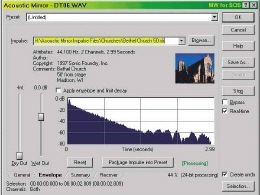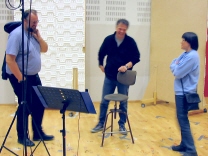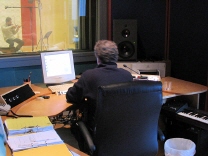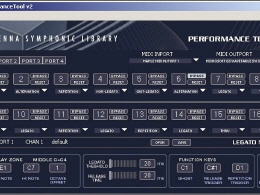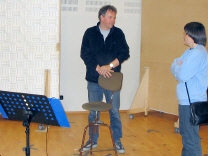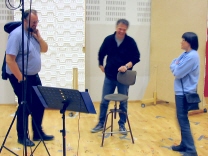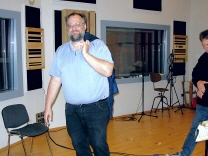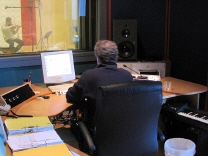20 Years "VSL" ...from a Customer's Perspective
- English
- Some Demos from that time...
- ¦¦ Deutsch
- Ein paar Demos aus jener Zeit
20 years of VSL history Kaufmann

Soon after the VSL foundation, in 2002, I bought my first VSL libraries "Orchesteral Strings" and the "Solo Strings" in 2003. The goal at that time was to create playbacks for saxophone and vocals, because my biggest wish was to be able to play and sing together with an orchestra, which I could not afford in reality. The quality of the VSL libraries was much better in sound than the one I already had (Peter Siedlaczek). Further it had much more articulations. Above all, all tones were usable. There were none that you always had to somehow work around using. Great!
Soon such first playbacks were created (the harpsichord was from another library):

I was pretty productive back then. You can find a few demos here.
Having an orchestra available day and night was incredibly motivating. Soon I had my first playbacks together to either sing or play saxophone to.
I was just enjoying a few years of vocal lessons at the time. This was simply for fun and out of interest in learning a new "instrument".
A few excerpts from the years 2004 and 2006:
VSL-Playback + Vocals / VSL-Playback + Saxophone
VSL+ Voice (various excerpts)
VSL+ Saxophone (G.F. Handel)
2004, Symphonic Cube

In 2004 I produced the piece Partita in E by J.S. Bach in an arrangement by Riccardo Pick Mangiagalli. I found the piece particularly successful and therefore sent it to Herb Tucmandl.
You can hear the original piece as it can still be found on the VSL website. The Chamberstrings did not exist yet, so it is a combination of the two libraries Orchestral Strings unisono with the Solostrings.
E-Partita Bach-Mangiagalli V2004

Herb Tucmandl was obviously thrilled. Anyway, he sent me all the other libraries with the request that I please produce demo pieces from now on to show the capabilities of the libraries.
Now I had a whole symphonic orchestra at my disposal overnight. Great! I was very happy.
E-Partita Bach-Mangiagalli V2021

By the way: Above is an newer version (2021) of the Partita.
See also https://youtu.be/zkTByhutvpI?si=ZVuFnPs2LAflcgse
Production tools at that time
The tools back then were somewhat different than today - less comfortable. I used LOGIC for WINDOWS as a DAW and HALION by Steinberg as a sample player. As reverb for positioning instruments I used Impulse (Acoustic Mirror) by Soundforge, a correlation reverb from Magix and a little later Gigapulse from Tascam.
The legato samples had to be played with an extra tool. It was called VSL Performance Tool. I never really became friend with it and it took me a long time to understand how to loop it in.
2005 Visit to Vienna
In 2005, together with my wife, I visited Vienna, Herb & Sabine and the Silent Stage with Michi Hula from VSL...
As if it was yesterday...
How did we newcomers learn to use samples?
Initially there was nothing, no tutorial, no instruction on how to create an orchestral sound with the extremely dry samples. Soon it was clear that the reverb plug-ins were the key to success. But the most important tool was always "the ears". We rehearsed a bit and compared again with original recordings. Then we exchanged our findings in the forum. In the beginning, we were a relatively small family that profited a lot from each other. That's how my website came into being, by the way. By writing down important things, so I didn't have to constantly repeat what there was to say about a topic. In 2008 I wrote 2 tutorials. One about the samples and the midi side and the other about samples and the audio side.
The key: Copy as accurately as possible

Here again is how I used to approach music with samples. First, I usually looked for a great recording (record or CD). Here below - as an example - an excerpt from Beethoven's 9th Symphony.
Then I played in the midi notes from the pocket score and synchronised the tempo of the midi file with the real sound recording in hard work.

Then it was a matter of providing the individual instruments with samples in such a way that the instruments sound as alike as possible - that is, in terms of volume and articulations.
Once all the instruments had been treated in this way, I created audio files for each (... because my computer was not able to hold the samples of a whole orchestra in RAM - also the PC performance was still very weak... ).
Now it was a question of the positions of the instruments in the orchestra from left to right and, of course, in which depth of space each instrument plays. There again, exact listening to the original was required. So it was a question of producing a mix that sounded quite similar to the original. In this way, I and we, the first users of VSL samples, gradually acquired the skills that help us old hands of the first hour today to achieve an orchestra-like performance.
The example shows above all the synchronisation of the midi file with the original (tempo) and below the most exact copying of the bass part. I did not yet copy the other instruments as accurately as possible...
Original
with Samples of VSL
2010-2021

- From 2010 on, I had no time to produce demos anymore, because my company demanded 120% effort from me in the meantime.
- VSL meanwhile developed MIR to make it easier for users to create an orchestral mix with the dry samples.
I never really liked the sound of MIR mixes, sorry to say that. But I never had any problems making a mix myself. So I didn't have to rely on MIR's help.
Later, VSL bought SYNCHRON Stage and the new SYNCHRON libraries were created.

The great thing about it, you can place any instrument on the SYNCHRON stage with these SYNCHRON libraries (within the SYNCHRON Player) and the different microphones, without an extra reverb, MIR or anything else.
I bought several SYNCHRON libraries over time and started producing more pieces again during the Corona period. For these new mixes - now with the SYNCHRON libraries - I use my own mix presets even if VSL offers many of them. The reason is, that I like to work with the samples as they where recorded - so with the VSL-Preset "DEFAULT". My current demos show (Synchron-Libraries-Audio-Demos) that even today's new SYNCHRON libraries can still produce top results, especially in terms of sound quality.
The "20-year experience" is accessible...

All tips and hints are a valuable collection of knowledge and experience from the last 20 years. These tips are all freely available - either as texts but also as videos. Links to them are among others:
Tutorial "Music with Samples" (free) / Work - Files / Free Tutorials

As for mixing, over several months I created a tutorial that contains all the most important tricks for mixing an orchestra and is constantly growing - a concentrate of more than 20 years of knowledge. I hope you understand that such a concentrate and uniquely valuable document may cost the amount of a private lesson.
Beat Kaufmann
ca. 2007, VI Cube
Flight_Close_The_Clouds mp3
-------------------------------------------------------------------
Beat Kaufmann
ca. 2008, VI Cube
Heckelphone, Articulation-Demos mp3
-------------------------------------------------------------------
Beat Kaufmann
ca. 2010, VI Cube
Jazz Ballade mp3
-------------------------------------------------------------------
Beat Kaufmann
ca. 2010, Out of the Tutorial "Arranging Strings"
Arrangements with Strings mp3
-------------------------------------------------------------------
Beat Kaufmann
2007, solo Violin on a Live Stage...
Nice Meeting mp3
-------------------------------------------------------------------
John Williams
2008, Starwars Snippet mp3
-------------------------------------------------------------------
Edward Elgar
ca. 2010, Pomp and Circumstances mp3
(from p to fff)
-------------------------------------------------------------------
Beat Kaufmann
2007, VI Cube 4 Signets (for Film or TV)
Signet 1 / Signet 2 / Signet 3 / Signet 4
-------------------------------------------------------------------
Beat Kaufmann
2008, VI Cube
"Sample March" mp3
-------------------------------------------------------------------
J.S.Bach, BWV 565 Fuge in Dm
2005, VI-Cube, Arrangement fpr Symphony Orchestra, Beat Kaufmann
BWV 565 Fuge in Dm mp3
-------------------------------------------------------------------
J. G. Stimson
2006, VI-Cube + Cubase Synths: Hard to say Goodby
Arranged and played (all Saxophones as well): Beat Kaufmann
Hard to say mp3
-------------------------------------------------------------------
It's great what was already possible back then, isn't it?
20 Jahre VSL-Geschichte Kaufmann

Schon bald nach der VSL-Gründung, 2002, kaufte ich 2003 meine ersten VSL-Libraries "Orchesteral Strings" und die "Solo Strings". Ziel war damals, mir Playbacks zu Saxophon und Gesang zu erstellen, denn mein grösster Wunsch war, zusammen mit einem Orchester spielen und singen zu können, was ich mir in der Wirklichkeit nicht leisten konnte. Die Qualität der VSL-Libraries war deutlich besser im Klang, als jene, die ich schon hatte (Peter Siedlaczek). Weiter hatte sie viel mehr Artikulationen. Vor allem waren aber alle Töne zu gebrauchen. Da waren keine dabei, deren Nutzung man immer irgendwie umgehen musste. Toll!
Es entstanden schon bald solche ersten Playbacks (das Cembalo war aus einer anderen Library):

Damals war ich ziemlich produktiv. Ein paar Demos finden Sie hier.
Die Tatsache Tag und Nacht ein Orchester zur Verfügung zu haben, motivierte unglaublich. Schon bald hatte ich meine ersten Playbacks zusammen, um dazu entweder zu singen oder Saxophon zu spielen.
Ich genoss zu jener Zeit gerade ein paar wenige Jahre Gesangsunterricht. Dies einfach zum Vergnügen und aus Interesse daran, ein neues "Instrument" kennen zu lernen.
Ein paar Auszüge aus den Jahren 2004 und 2006:
VSL-Playback + Gesang / VSL-Playback + Saxophon
VSL+ Gesang (verschiedene Auszüge)
VSL+ Saxophon (G.F. Händel)
2004, Symphonic Cube

2004 produzierte ich das Stück Partita in E von J.S. Bach in einem Arrangement von Riccardo Pick Mangiagalli. Ich fand das Stück besonders gelungen und schickte es deshalb Herb Tucmandl.
Sie hören das Originalstück, wie es heute noch auf der Website von VSL zu finden ist (Musik). Die Chamberstrings gab es noch nicht. Es ist eine Kombination der beiden Libraries Orchestral-Strings unisono mit den Solostrings.
E-Partita 2004
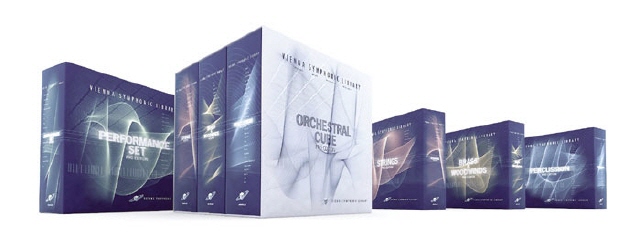
Herb Tucmandl war offenbar begeistert. Jedenfalls schickte er mir die ganzen anderen Libraries mit der Bitte, ich solle doch bitte fortan Demo-Stücke produzieren, um die Fähigkeiten der Libraries zu zeigen.
Nun hatte ich über Nacht ein ganzes Sinfonieorchester zur Verfügung. Toll!
E-Partita, Version 2021

Nebenbei: Oben die Version 2021 der Partita.
Es gibt sie auch auf Youtube https://youtu.be/zkTByhutvpI?si=ZVuFnPs2LAflcgse
Produktions Tools damals
Die Tools damals waren noch etwas andere als heute - weniger komfortabel. Als DAW verwendete ich LOGIC for WINDOWS und als Sample-Player kam bei mir HALION von Steinberg zum Zug. Als Hall zum positionieren von Instrumenten gabe es Impulse (Acoustic Mirror) von Soundforge, einen Correlationhall von Magix und etwas später Gigapulse von Tascam.
Die Legato-Samples musten noch mit einem Extratool gespielt werden. Es hiess VSL-Performance-Tool. Ich wurde nie richtig Freund damit und hatte lange, bis ich begriff, wie man es einschleifen musste.
2005 Besuch in Wien
2005 besuchte ich zusammen mit meiner Frau Wien, Herb & Sabine und die Silentstage mit Michi Hula von VSL...
Als ob es gestern gewesen wäre...
Wie lernten wir Neulinge Samples anzuwenden?
Anfänglich gab es nichts, kein Tutorial, keine Gebrausanweisung, wie man einen Orchesterklang hinbekommt mit den äusserst trockenen Samples. Bald war klar, dass die HallplugIns der Schlüssel zum Erfolg waren. Das wichtigste Tool aber waren immer wieder "die Ohren". Man proberte etwas und verglich wieder mit Originalaufnahmen. Dann tauschten wir unsere Erkenntnisse im Forum aus. Wir waren anfänglich eine relativ kleine Familie, die sehr profitierte von einander. So entstand übrigens meine Website. Indem ich Wichtiges festhielt, musste ich nicht ständig wiederholen, was es zu sagen gab rund um ein Thema. Im Jahr 2008 schrieb ich 2 Tutorials. Eines über die Samples und die Midi-Seite und das andere über Samples und die Audio-Seite.
Der Schlüssel: Möglichst genau kopieren

Hier noch einmal, wie ich früher an die Musik mit Samples heran ging. Zuerst suchte ich mir meistens eine tolle Einspielung (Schallplatte oder CD). Hier unten - als Beispiel - ein Auszug aus Beethovens 9. Sinfonie.
Danach spielte ich die Midinoten ab Taschenpartitur ein und synchronisierte in mühsamer Arbeit das Tempo der Midi-Datei mit der reellen Tonaufnahme.

Nun ging es darum, die einzelnen Instrumente so mit Samples zu versehen, dass die Instrumente möglichst gleich tönen - also von der Lautstärke und den Artikulationen her gesehen.
Waren alle Instrumente so behandelt, erstellte ich jeweils Audiofiles (... denn mein Computer war nicht in der Lage, die Samples eines ganzen Orchesters im Arbeitsspeicher zu halten - auch die PC-Leistung war noch sehr schwach... ).
Nun ging es um die Positionen der Instrumente im Orchester von Links bis Rechts und natürlich in welcher Raumtiefe welches Instrument spielt. Da war wiederum genaues Hören beim Original gefragt. Es ging also darum, einen Mix herzustellen, der ziemlich ähnlich dem Original klang. So erlangte ich und erlangten wir ersten Anwender der VSL-Samples nach und nach die Fähigkeiten, welche uns alten Hasen der ersten Stunde heute helfen, eine Orchester-ähnliche Performance zu erreichen.
Das Beispiel zeigt vor allem, das Synchronisieren des Midi-Files mit dem Original (siehe oben, Tempo) und unten das möglichst genaue Kopieren der Bass-Stimme. Die anderen Instrumente kopierte ich noch nicht möglichst genau...
Original
mit Samples von VSL
2010-2021

- Ab 2010 hatte ich keine Zeit mehr, Demos zu produzieren, denn meine Firma verlangte unterdessen 120% Einsatz von mir.
- VSL entwickelte unterdessen MIR, damit es den Anwendern einfacher geht, mit den trockenen Samples ein Orchestermix herzustellen.
Mir gefiel der Sound von MIR-Mixen nie besonders. Ich hatte aber auch nie Probleme, selber einen Mix hinzukriegen. Ich war also auf die Hilfe von MIR nicht angewiesen.
Später kaufte VSL die SYNCHRON Stage und es entstanden die neuen SYNCHRON-Libraries.

Das Tolle daran, man kann mit diesen SYNCHRON-Libraries und den verschiedenen Mikrofonen (im Synchron Player) jedes Instrument in der SYNCHRON-Stage platzieren, ohne einen Extra-Reverb, MIR oder sonst etwas.
Ich kaufte ich im Laufe der Zeit mehrere SYNCHRON-Libraries und begann in der Corona-Zeit, wieder vermehrt Stücke zu produzieren. Für diese neuen Mixe - nun mit den SYNCHRON-Libraries - verwende ich keine VSL-Presets, sondern meine eigenen (als Basis dienen die DEFAULT-Einstellungen im Synchronplayer). Meine aktuellen Demos zeigen (Synchron-Libraries-Audio-Demos ), dass auch die heutigen neuen SYNCHRON-Libraries nach wie vor Spitzenresultate - besonders punkto Soundqualität - produzieren können.
Die "20-Jahre Erfahrungen" sind zugänglich...

Alle Tips und Hinweise sind eine wertvolle Ansammlung von Wissen und Erfahrungen aus den letzten 20 Jahren. Diese Tips sind alle frei zugänglich - entweder als Texte aber auch als Videos. Links dazu sind unter anderem:
Tutorial "Music with Samples" (free) / Work - Files / Free Tutorials

Was das Mischen anbelangt, erschuf ich über mehrere Monate ein Tutorial, das alle die wichtigsten Tricks zum Mischen eines Orchesters enthält und ständig weiter wächst - ein Konzentrat aus mehr als 20 Jahren Wissen. Ich hoffe, Sie verstehen, dass ein solches Konzentrat und einmalig wertvolles Dokument den Betrag einer Privatlektion kosten darf.
Beat Kaufmann
ca. 2007, VI Cube
Flight_Close_The_Clouds mp3
-------------------------------------------------------------------
Beat Kaufmann
ca. 2008, VI Cube
Heckelphone, Articulation-Demos mp3
-------------------------------------------------------------------
Beat Kaufmann
ca. 2010, VI Cube
Jazz Ballade mp3
-------------------------------------------------------------------
Beat Kaufmann
ca. 2009, Out of the Tutorial "Arranging Strings"
Arrangements with Strings mp3
-------------------------------------------------------------------
Beat Kaufmann
2007, solo Violin on a Live Stage...
Nice Meeting mp3
-------------------------------------------------------------------
John Williams
2008, Starwars Snippet mp3
-------------------------------------------------------------------
Edward Elgar
ca. 2010, Pomp and Circumstances mp3
(from p to fff)
-------------------------------------------------------------------
Beat Kaufmann
2007, VI Cube 4 Signets (for Film or TV)
Signet 1 / Signet 2 / Signet 3 / Signet 4
-------------------------------------------------------------------
Beat Kaufmann
2008, VI Cube
"Sample March" mp3
-------------------------------------------------------------------
J.S.Bach, BWV 565 Fuge in Dm
2005, VI-Cube, Arrangement fpr Symphony Orchestra, Beat Kaufmann
BWV 565 Fuge in Dm mp3
-------------------------------------------------------------------
J. G. Stimson
2006, VI-Cube + Cubase Synths: Hard to say Goodby
Arranged and played (all Saxophones as well): Beat Kaufmann
Hard to say mp3
-------------------------------------------------------------------
Toll, was damals schonmöglich war, nicht?
